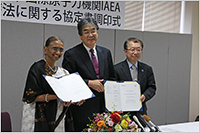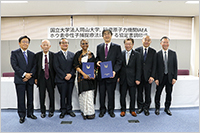Enlarge Image Commemorative photograph of the participants in the signing ceremony.
Enlarge Image
Okayama University and International Atomic Energy Agency sign an agreement for the development of Boron Neutron Capture Therapy (BNCT) for cancer therapy
Okayama University and the International Atomic Energy Agency (IAEA) concluded an agreement on 26 October 2016 for the development of boron neutron capture therapy (BNCT)—a new approach to cancer treatment.
President Kiyoshi Morita and Executive Director/Vice President of Research Shin-ichi Yamamoto from Okayama University and Dr Meera Venkatesh, Director of the Division of Physical and Chemical Sciences in the Department of Nuclear Sciences and Applications at IAEA, signed the agreement at a ceremony held at Okayama University. Notably, this is the first agreement in the world to be concluded on BNCT with the IAEA.
“It is an enormous honor to conclude a cooperative agreement on boron neutron capture therapy,” said President Morita during his speech at the ceremony. “BNCT is a cancer treatment with great potential, and a therapy resulting from the fortuitous encounter of modern elementary particle physics with new pharmaceutical cellular biology. I am confident that this agreement will further strengthen the relationship between Okayama University and IAEA, and lead to new developments in BNCT.”
Executive Director Yamamoto emphasized his hope that a broad range of knowledge will be shared in the field of radiotherapy, saying, “BNCT is a technology integrating the medical, pharmaceutical and physical sciences. Through this agreement with the IAEA, we aim to contribute to education and research in this innovative field.”
In her speech, Director Venkatesh said, “The IAEA is committed to accelerate and enlarge the contribution of atomic energy to peace, health and development around the world. There have been many important advances in cancer therapy recently, but still with numerous challenges ahead. The IAEA Member States will also benefit from cooperation with internationally recognized institutions, such as Okayama University. We have not seen much progress in BNCT for a few decades. However, the ‘Side Event’ we organized during the IAEA’s General Conference in September 2016 urged us to re-examine the current status of this therapy, focusing in particular on the recent development of new boron compounds and effective neutron sources generated in accelerators.”
Professor Hideki Matsui of the Graduate School of Medicine, Dentistry and Pharmaceutical Sciences, who has developed a boron compound that can reach cancer cell nuclei, said, “BNCT may be the most promising cancer treatment available. If a compound containing B-10 can be injected into each cancer cell which is then exposed to a neutron beam, the cancer cell can be killed by the boron-neutron reaction within the cell.”
Importantly, Okayama University and the IAEA already have cooperative relationship even prior to the conclusion of this agreement, having previously organized previously two joint symposia; Okayama University inviting specialists from the IAEA; organizing an international workshop in 2015 titled, ‘The Current and a Future of Radiation’; and a symposium in 2016 titled, ‘The Current and a Future of Radiation and External Beam Therapy’.
These activities were important for this agreement on research and education program on BNCT. Professor Matsui and Professor Yasuaki Ichikawa of the Organization for Research Promotion & Collaboration are engaging in further cooperative activities with the IAEA.
Further information
Okayama University website
http://www.okayama-u.ac.jp/eng/news/index_id6296.html


